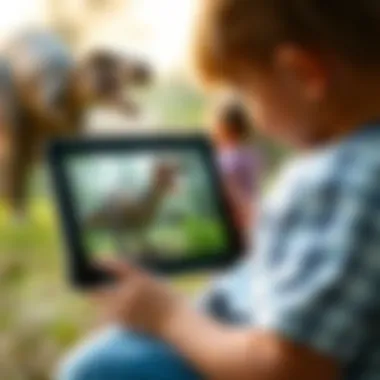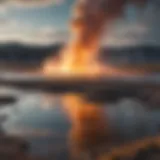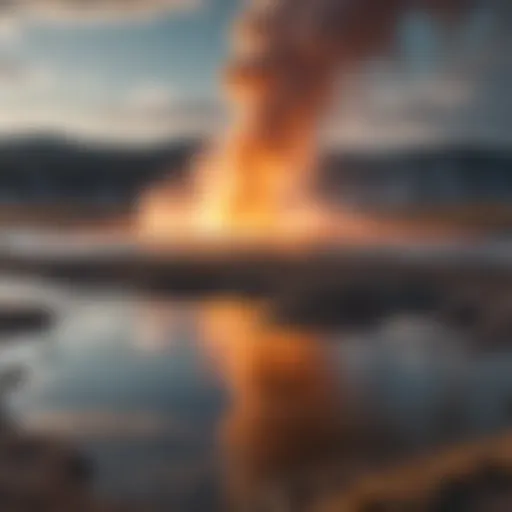Engaging Videos for Exploring Dinosaurs


Nature Topic Overview
Dinosaurs have always captured our imagination, serving as a bridge to an ancient past filled with colossal creatures and untold stories. As we dive into the diverse world of these magnificent beings through videos, we uncover not just their size and form but also their behaviors, habitats, and ultimately, their environments. This age-old fascination has found new life in a modern context — bringing science to young eyes in a way that is both fun and educational.
Engaging videos about dinosaurs are invaluable resources that cater to kids aged 5-12 years, their parents, and educators. The way these videos present complex concepts in bite-sized snippets fosters a love for learning. They become pathways to deeper conversations about science, evolution, and the Earth’s history. Kids can feel like they’re journeying back in time, witnessing the drama of survival and adaptation firsthand.
Each video serves a purpose, educating young minds while keeping them entertained. They come in various formats — from animated series that breathe life into these ancient titans to documentaries that dig into the nitty-gritty details of paleontology. It's important to note that the more engaging the video, the more learning sticks with children.
Fun Facts and Trivia
In the sprawling fields of knowledge about dinosaurs, certain tidbits pique interest and spark curiosity:
- Did you know that the Tyrannosaurus rex had a bite force strong enough to crush bones? It’s true! Imagine those jaws!
- Contrary to the big, scaly image we often see, some dinosaurs, like the Velociraptor, had feathers – yes, feathers! It makes you wonder how they really looked.
- The name dinosaur comes from the Greek words deinos (terrible) and sauros (reptile). So, it literally means „terrible lizard”, although they weren’t lizards at all.
- There existed species like the Sauroposeidon, which could reach heights of up to 60 feet – that’s as tall as a six-story building!
Visuals can amplify the impact of these facts. Integrating interactive quizzes, animations, and striking images can turn mere facts into engaging stories, making it not simply intellectual but an emotional experience.
Wildlife Explorations
The world of dinosaurs is a vast one, home to an array of fascinating species. Kids can begin to imagine these creatures roaming free, all while discovering their unique characteristics.
Featured Dinosaurs
- Triceratops: Known for their three horns and a massive frill, they were plant-eaters roaming in herds. Wouldn’t it be something to see them grazing peacefully?
- Stegosaurus: With its plates jutting out from its back, this dinosaur seemed to have armor against predators. But did it use its tail spikes as a defense mechanism?
- Brachiosaurus: A gentle giant, often mistaken for a brontosaurus, loved to munch on treetops – as they stood over 40 feet tall. Just think of a giraffe, but on a much larger scale!
Habitat Insights
Exploring the habitats these dinosaurs occupied can unveil how they thrived. Many lived in vivid, tropical environments or arid landscapes. Videos portraying these ecosystems can highlight not just the dinosaurs themselves but other creatures and plants that existed alongside them, painting a fuller picture of their world.
Important Note: Understanding the interaction between species and their environment helps foster respect for wildlife and ecological principles in young viewers.
Environmental Awareness
The significance of conservation cannot be overlooked when watching these videos. Dinosaurs thrived on Earth for millions of years before they vanished. Learning about their extinction can encourage discussion on the importance of sustainability today.
Encouraging children to reflect on the environment leads to greater awareness. Here are a few small yet impactful actions they can take:
- Reducing waste by recycling paper and plastic.
- Participating in community clean-up days at parks or beaches.
- Planting trees or even a small garden at home.
Every bit helps, and who knows? Maybe the next great paleontologist will be inspired right from their living room!
DIY Nature Activities
There's something truly special about hands-on learning. Engaging kids in activities can reinforce the lessons found in those captivating videos:
- Create a Dinosaur Fossil: Use flour, salt, and water to mold small dinosaur shapes, and then bake them to harden. Kids can later paint them!
- Make a Dino Diorama: Shoeboxes can transform into a prehistoric setting. Gather twigs, leaves, and clay to recreate a scene with dinosaurs.
- Outdoor Exploration: Take a nature walk and look for animal tracks, plants, or stones that seem to tell tales of the past.
By combining creativity and exploration, children actively immerse themselves in learning. Better yet, it creates a lasting connection with the subject.
This multifaceted approach to understanding dinosaurs and their environments through videos not only aids in education but also nurtures a deeper respect for our planet and its history.
Understanding Dinosaurs
Understanding dinosaurs is an essential part of our journey through the prehistoric past. It allows both children and adults to grasp the enormity of these creatures, as well as their role within Earth's history. Dinosaurs, with their remarkable diversity and adaptations, serve as a gateway for young learners to explore scientific concepts like evolution, extinction, and environments. Engaging videos play a pivotal role in making this knowledge accessible and digestible, breaking down complex ideas into enjoyable bites that are relatable for kids aged 5-12.
What are Dinosaurs?
Dinosaurs were a broad group of reptiles that roamed the Earth during the Mesozoic Era, which lasted around 180 million years. They came in various shapes and sizes, from the massive Argentinosaurus to the small, feathered Microraptor. This diversity can spark curiosity in young minds, urging them to ask, "What did they eat? How did they live?"
The term dinosaur itself means "terrible lizard" in Greek, but dinosaurs are more closely related to birds than reptiles. This fact can often captivate children’s imaginations, encouraging them to make connections that extend beyond surface-level knowledge. Videos like those found on YouTube or in animated films can show the dynamic life of dinosaurs, presenting them as creatures that once thrived in ecosystems similar to our own.
The Age of Dinosaurs


The Age of Dinosaurs, also known as the Mesozoic Era, is divided into three periods: the Triassic, Jurassic, and Cretaceous. Each of these periods brought different types of dinosaurs and significant changes in the environment. Children can visualize this through videos that illustrate the gradual shift in flora and fauna, from the earliest dinosaurs like Coelophysis in the Triassic to the gigantic Tyrannosaurus rex in the late Cretaceous.
- Triassic Period: This period introduced the first dinosaurs alongside other reptiles. It was a time when the supercontinent Pangaea was eliminating barriers, which further facilitated species migration.
- Jurassic Period: This is when dinosaurs became dominant! Kids get to see how the long-necked Brachiosaurus wandered the lush landscapes and how fearsome creatures like the Allosaurus hunted.
- Cretaceous Period: The grand finale of the Age of Dinosaurs. This period is most recognized for the extinction events, including the famous asteroid impact that brought an end to the reign of the dinosaurs. Videos can effectively depict the environments and lifestyles during this time, indulging a viewer's imagination.
"Dinosaurs were not just monsters; they were part of an intricate web of life that shaped our planet."
The Appeal of Dinosaur Videos
Dinosaur videos have an undeniable charm that draws children and adults alike into the vast, distant past. It’s not just about the awe of gigantic creatures; it is also about how these videos spark curiosity and a deeper understanding of natural history. In the context of this article, examining the appeal of dinosaur videos reveals how they turn learning into an adventure. The combination of vivid visuals and scientific narratives transforms basic facts about paleontology into engaging stories.
Visual Learning for Kids
Many kids learn better when they can see things in action. Dinosaur videos provide a visual feast that is hard to resist. Through vibrant animations and real-life simulations, children can watch dinosaurs roam ancient landscapes. This sort of visual learning caters to various learning styles, especially for those who might struggle with traditional teaching methods.
For instance, a child learning about the Tyrannosaurus rex won't just read about it; they'll see it chase prey in a dynamic setting. This truly brings facts to life. Key benefits include:
- Retention of Information: A well-crafted video can help kids remember dinosaur names, behaviors, and their environments long after the video is over.
- Enhanced Understanding: Visual representations can clarify complex concepts, such as how different dinosaurs compared in size or unique adaptations for survival.
- Motivation to Explore: Sometimes, it starts as simple fascination. A child may enjoy a dino video, which later spurs an interest in reading books or visiting a museum.
Captivating Storytelling Elements
Telling stories is an ancient art, and merging that with factual information makes these videos all the more riveting. Children are naturally drawn to narratives, and dinosaur videos often incorporate storytelling elements that can captivate young minds. Including elements like conflict, resolution, and character development makes learning feel personal and relatable.
Take, for example, a narrative about a small Velociraptor working together with its pack to catch food. This story is not only entertaining but also provides insight into the social behavior of the species. Here’s why captivating storytelling in dino videos works so well:
- Emotional Connection: By placing dinosaurs in scenarios that reflect feelings or challenges, kids relate and engage their emotions, whether it's awe at a massive dinosaur or empathy for a struggling creature.
- Foundational Skills: Many narratives encourage critical thinking as children begin to question and analyze the situation. Who are the characters? What challenges do they face? This kind of questioning is intrinsic to learning.
- Exploration of Themes: With storytelling comes the chance to dive deeper into themes like extinction or adaptation, which broadens the child's understanding of life on Earth.
"The best stories not only teach us about the world but also awaken a thirst for knowledge. Dinosaur videos do just that."
Types of Dinosaur Videos
Dinosaur videos come in various forms, each catering to different learning styles and preferences. These visual formats play a crucial role in educating young minds about these prehistoric creatures. From documentaries that dive deep into scientific facts to imaginative animated features, there’s a treasure trove of content available. Understanding the different types of dinosaur videos can help parents and educators select the most beneficial resources for children aged 5-12.
Documentaries and Educational Series
Documentaries about dinosaurs are like windows into the past. They usually showcase real-life discoveries, paleontologists’ findings, and dramatic recreations of how dinosaurs might have lived. What’s fascinating about these videos is how they blend storytelling with real science. They present facts in a way that can ignite a child’s curiosity. Kids see not only the dinosaurs but also the environments they inhabited.
A well-made documentary can:
- Educate viewers about the different dinosaur species.
- Discuss the geological timeline, showing how long ago these creatures roamed the Earth.
- Explain fossilization processes, making paleontology more relatable.
For instance, the series Walking with Dinosaurs stands out for its groundbreaking visuals and engaging narrative. Children can visualize large creatures like the Tyrannosaurus rex hunting, which makes the learning experience memorable. Such educational series not only inform but also connect emotionally with young viewers.
Animated Features
Animated dinosaur videos offer a dynamic and entertaining way to learn. They often create imaginative scenarios that wouldn’t be possible in a documentary. Through colorful animations, kids can see dinosaurs interacting in amusing or action-packed plots. This approach engages their imaginations, allowing for a creative interpretation of how these creatures might have lived.
With animated features, which include films like The Good Dinosaur, children learn while being entertained. These videos can:
- Foster empathy, as characters often navigate challenges similar to those faced by youngsters today.
- Inspire imaginative play, allowing kids to envision themselves in prehistoric times.
- Introduce basic scientific concepts without feeling like a formal lesson.
The blend of education and fantasy helps make the topic of dinosaurs accessible and fun. It allows children to explore their curiosity without the weight of academic pressure.
YouTube Channels and Online Content
In the age of digital media, YouTube has emerged as a platform bursting with dinosaur content. Numerous channels focus solely on delivering kid-friendly educational material. These channels can be a treasure chest of quick videos, animations, discussions, and even interviews with real paleontologists.
Some notable channels include:
- National Geographic Kids, which offers entertaining clips full of facts.
- SciShow Kids, blending science with fun, often features segments on dinosaurs.
- Cosmic Kids Yoga, which even incorporates dinosaur-themed workouts!
The beauty of YouTube lies in its flexibility and diversity. Parents can easily vet content, and many channels allow children to interact through comments or quizzes. There are endless possibilities for learning in less traditional formats.
Choosing the right video format also depends on a child’s interests. While one child may prefer the factual style of a documentary, another might lean toward the vibrant characters found in animated stories. Regardless of the choice, these types of videos significantly contribute to a well-rounded understanding of dinosaurs, marrying education with entertainment.


"Kids today benefit from diverse learning tools, allowing them to explore the world of dinosaurs in a multitude of ways."
In summary, understanding the varied types of dinosaur videos can transform learning into a delightful voyage through time, ensuring that children are not just passive consumers but active learners in their exploration of these fascinating creatures.
Key Educational Themes
Understanding the key educational themes surrounding dinosaurs is essential for unlocking the treasures that engaging videos provide. This section explores the foundations of paleontology, the various habitats of dinosaurs, and the evolutionary journey these magnificent creatures undertook. By taking a closer look at these themes, we delve into how they enrich a child’s comprehension and spark an interest in the prehistoric world.
Paleontology Basics
Paleontology, the study of ancient life, is like piecing together a giant jigsaw puzzle of the past. It builds foundational knowledge about dinosaurs—what they looked like, how they lived, and what made them tick. Videos that break down complex concepts into digestible nuggets help children grasp the basics without feeling overwhelmed.
For example, engaging animations can show the skeletal structure of a Tyrannosaurus rex, explaining its massive legs and sharp teeth. Knowing such details not only captivates little minds but gives them a basic scientific literacy which can be useful in later education.
"Learning about dinosaurs can be a marvelous way to foster curiosity in kids, inviting them to ask questions and seek answers."
Another key aspect is how videos can emphasize scientific methods. Demonstrating how fossils are discovered or how prehistoric climates changed can inspire a sense of inquiry. Children learn by example, and seeing how paleontologists work might encourage young viewers to explore science further.
Dinosaurs in Their Habitats
Dinosaurs didn't just roam around aimlessly; they adapted to various habitats, much like today’s animals. Videos that portray these diverse environments—be it lush jungles, arid deserts, or icy tundras—give context to understanding these creatures.
Explaining different habitats not only adds depth to the narrative but also allows kids to connect emotions to the facts. For instance, a scene depicting a Brachiosaurus munching on treetops can evoke wonder, while a short focus on a Velociraptor hunting in a pack paints a picture of survival.
By narrating these tales, videos can also touch on themes of ecosystems and interdependence. Understanding how dinosaurs interacted with their surroundings and fellow creatures lays the groundwork for grasping fundamental ecological concepts. This is key to creating well-rounded learners who appreciate nature's intricacies.
The Evolution of Dinosaurs
Evolution is a big word, but it doesn’t have to be confusing. Snapshot videos that trace the evolutionary timeline of dinosaurs help simplify this concept. Showing how dinosaurs evolved over millions of years into various species illustrates change and adaptation, fundamental aspects of biology.
Imagine a video that shows the transformation from feathered dinosaurs to birds. This progression can astonish kids, demonstrating that creatures of the past are still connected to the world around them!
Children can also explore extinction events, learning why the dinosaurs disappeared from Earth—this not only teaches history but fosters compassion for endangered species today. Highlighting evolution can remind them of the importance of conservation, making learning impactful both for the past and present.
By exploring these key educational themes through engaging videos, we don’t just inform children about dinosaurs—we ignite a passion for learning that can last a lifetime. This knowledge becomes a stepping stone towards deeper understanding, impacting their views on science, history, and the environment.
Interactivity in Learning
Interactivity plays a central role in learning, particularly for young minds eager to grasp the marvels of the ancient world. When children engage actively with educational content, they don’t just passively consume information; they become part of the narrative. This engagement promotes deeper understanding and retention. With dinosaurs, the thrill of hands-on experiences can make a world of difference, transforming dry facts into vibrant, memorable images.
Interactive elements can include quizzes, games, and virtual experiences that allow kids to explore concepts at their own pace and in their own style. This approach is particularly useful since it caters to various learning styles, from kinesthetic learners who thrive on movement to visual learners who absorb information through images and colors.
Quizzes and Challenges
Quizzes related to dinosaurs can serve more than just a fun diversion; they also reinforce the learning material. When kids answer questions about T. rex’s diet or the habitats of Apatosaurus, they're not simply recalling facts. They're making connections and applying their knowledge.
- Immediate Feedback: These quizzes often provide instant results, allowing children to understand which areas they excel in and what they might need to revisit.
- Competition and Motivation: By incorporating a gamified element, whether through leaderboards or timed challenges, children become more motivated. Friendly competition can spark a keen interest in learning.
- Adaptability: Many platforms now offer quizzes tailored to different age groups and knowledge levels, making it easy for parents and teachers to find suitable challenges for their students.
Virtual Field Trips to the Mesozoic Era
Taking a virtual field trip to the Mesozoic Era can be like stepping through a time portal. Imagine kids roaming through a digital landscape filled with lush vegetation and towering dinosaurs, all from the comfort of their homes or classrooms.
- Immersive Experiences: These virtual excursions can include 3D environments where users interact with prehistoric life, witnessing how these creatures moved and behaved in their habitats.
- Expert Guidance: Many of these tours are led by paleontologists or educators who add context and details, enhancing the educational value. Special attention is given to questions like how dinosaurs adapted to their environments or how fossils are formed.
- Encouraging Curiosity: After a virtual field trip, discussions can unfold about different dinosaur species, their diets, and even the weather conditions of those eras, sparking natural curiosity and deeper inquiry.
"Educational interactivity transforms learning from a task into an enjoyable adventure, fostering a lifelong love of inquiry and exploration."
Impact of Dinosaur Videos on Children
Dinosaur videos hold a unique allure for children, capturing their attention and sparking their imagination. The impact of these audiovisual tools on young minds is profound, influencing their cognitive and emotional development. They not only provide entertainment but serve as valuable portals to the past, unveiling the secrets of our prehistoric counterparts. In this section, we will explore two core aspects: enhancing curiosity and engagement, and fostering critical thinking skills.
Enhancing Curiosity and Engagement
Children possess an innate curiosity about the world, and videos about dinosaurs play a crucial role in nurturing this trait. Dinosaur videos offer a visual feast, filled with vibrant animations and thrilling narratives, which can easily draw a child’s attention. These captivating visuals present dinosaurs in dynamic settings, transporting kids into imaginary worlds where they can see these giants in action.


The vibrant landscapes foster an environment of engagement, making children not just passive viewers but active participants in their learning. Here are key elements that enhance curiosity and engagement:
- Dynamic Visuals: The use of cutting-edge graphics and animations creates a visually stimulating experience. It’s delightful for children to see dinosaurs roaming through lush jungles or soaring over prehistoric seas.
- Storytelling: Videos often weave engaging stories around dinosaurs, giving personality to the creatures and creating memorable characters. This storytelling element keeps children glued to the screen, waiting to find out what happens next.
- Sound Effects and Music: Well-crafted sound design adds excitement, making moments exhilarating and somewhat interactive, prompting kids to React.
As they engage with the content, children develop an appetite for knowledge. They may become inclined to delve deeper—asking questions about different species, their habitats, and extinction. This exploration can lead to children picking up books on dinosaurs or engaging in discussions with teachers and parents.
Encouraging Critical Thinking Skills
Beyond mere curiosity, dinosaur videos can significantly promote critical thinking skills among children. These videos often present complex ideas in an easily digestible format, allowing young viewers to connect various concepts and draw their conclusions.
Here’s how these videos foster critical thinking:
- Problem-Solving: Some videos may present challenges that dinosaurs faced in their environments, inviting children to think about adaptations and survival strategies. This encourages them to analyze the situation and devise solutions based on observed behaviors.
- Visualizing Concepts: The abstract concepts of evolution and extinction can be hard for kids to grasp. However, well-crafted documentaries break down these ideas into visual narratives, allowing children to visualize timelines and relationships between different species.
- Encouraging Questions: The content stimulates inquiry, prompting children to ask "Why?" and "How?" Questions that are fundamental to learning can spark discussions at home or in the classroom.
Finding Quality Content
In the digital age, children have access to a catapult of content. This explosion of resources can make it hard for parents and educators to discern which dinosaur videos genuinely contribute to a child’s understanding and appreciation of these magnificent creatures. Finding quality content is not just a trivial task; it’s essential for ensuring that the learning experience is both fun and informative. This section delves into how to identify worthwhile educational videos on dinosaurs and highlights key considerations to keep in mind while searching.
How to Choose Educational Videos
When it comes to selecting educational videos, parents and teachers should prioritize a few vital elements:
- Purpose and Clarity: Is the video designed to inform? Check the synopsis—what is the main goal? Content aimed at teaching should clearly outline what kids will learn about dinosaurs.
- Age Appropriateness: Not every video is suitable for every age group. Ensure the material is tailored for the target audience, in this case, kids aged between five and twelve. Videos with vibrant colors, engaging characters, and simple concepts are great for younger viewers.
- Scientific Accuracy: Confirm that the information presented is rooted in scientific facts. Misleading details can give kids a skewed perception of dinosaurs. Look for videos that cite credible sources or mention collaborations with paleontologists.
- Engaging Visuals: Quality animation or live-action footage can captivate a child’s imagination. Dynamic visuals spark curiosity and foster a deeper connection to what they are learning.
- Interactive Components: Videos that offer questions or activities can keep children involved. Encourage them to think critically about the content and reflect on their new knowledge.
With these points in mind, checking reviews or recommendations from other parents and educators can be a life-saver in this sea of content.
Platforms for Reliable Resources
To find solid dinosaur videos, certain platforms stand out for providing high-quality educational material:
- YouTube Kids: This platform curates age-appropriate content. Many channels focus exclusively on educational themes, making it easier for parents to find suitable videos.
- PBS Kids: Known for their educational programming, PBS offers a variety of resources, including engaging dinosaur videos.
- National Geographic Kids: This platform is rich in well-researched content, perfect for kids who are curious about the natural world, including dinosaurs. The combination of engaging visuals and factual accuracy is its strong point.
- Netflix and Amazon Prime Video: Both streaming services feature documentaries specifically aimed at children. Look for those that have high ratings or are produced by reputable sources.
"Choosing the right educational content can empower children, sparking their interest in science and history while equipping them with knowledge that lasts a lifetime."
To summarize, finding quality dinosaur videos involves understanding what kinds of materials will support a child's learning journey while entertaining them. With the right tools and approaches, exploring the world of dinosaurs becomes not only accessible but truly enriching.
Future of Dinosaur Content
The future of dinosaur content holds exciting possibilities, particularly as technology continues to evolve. Viewing dinosaurs through videos not only engages young minds but also builds a bridge to understanding complex scientific concepts. As parents, educators, and content creators look towards the horizon, several key elements come into play that will shape how these prehistoric giants are presented to the new generation.
Advancements in Visual Technology
One of the most significant breakthroughs is advancements in visual technology. Gone are the days of static images and basic animations. With high-definition graphics, virtual reality (VR), and augmented reality (AR), children can step into the world of dinosaurs like never before.
- Virtual Reality Experiences: Imagine putting on a VR headset and standing next to a towering Brachiosaurus, as it grazes from the tops of trees. This immersive experience can make learning exhilarating, as kids interact with lifelike recreations of these creatures without leaving their living rooms.
- High-Definition Documentaries: Documentaries now often utilize stunning visuals captured through sophisticated technologies, allowing for detailed studies of dinosaurs in their habitats. Kids can see not just how a T-rex looks but how it moves, hunts, and survives.
- Increased interactivity: Technology enables interactivity though apps that allow children to manipulate dinosaurs on-screen. Such features can enhance curiosity, making it possible for kids to generate their own learning paths.
As visual technology progresses, the portrayal of dinosaurs will become even more realistic and engaging. This not just defines how young people learn about the past but also creates a buzz that keeps them coming back for more.
The Role of Interactive Media
Alongside advancements in visual technologies, interactive media plays a pivotal role in the future of dinosaur content. It speaks to the hands-on nature of learning that remains crucial for children aged 5-12.
- Engaging Content: Interactive videos that involve quizzes, challenges, and games will hold children’s attention, compelling them to participate rather than simply observe. For instance, videos that ask viewers to predict a dinosaur’s behavior before showing what actually happened can stimulate critical thinking and engagement.
- Collaborative Learning: Interactive media allows for shared experiences in learning. Platforms hosting discussions or live streams can enable viewers to ask these burning questions about dinosaurs. This collaboration fosters a community of learners eager to explore, discover, and discuss.
- Real-Time Feedback: Many interactive games provide instant feedback on the child's performance. This immediate reflection helps children understand where they excel and where they might need more effort, guiding their learning journey.
Child-friendly apps and platforms can leverage this interactive approach, ensuring that learning about dinosaurs becomes an adventure, instead of mere textbook knowledge. Ultimately, this blend of accessibility and interaction makes the past feel relevant, sparking interest and appreciation.
"As technology advances, we find ourselves opening the door to the unimaginable—making dinosaurs come to life in ways we've only dreamt of."
Ending
The conclusion brings together the diverse threads of the discussion surrounding the impact of videos on children's understanding of dinosaurs. It serves as a pivotal moment to reflect on not just the information shared in the previous sections, but also on the broader implications of using engaging media to teach complex subjects. In the age of digital storytelling, videos offer much more than mere entertainment; they’re powerful tools for education.
The Lasting Impact of Dinosaurs on Young Minds
When children watch videos about dinosaurs, they are not just absorbing facts about Tyrannosaurus rex or Triceratops. They’re stepping into worlds filled with imagination, wonder, and learning. The vivid imagery and dynamic narratives captivate their attention, pulling them into a realm that seems far removed from their everyday experiences. This method of learning can have profound benefits.
- Fostering a Love for Science: Engaging dinosaur videos help to nourish a child's curiosity about paleontology and natural sciences. By presenting these concepts in a lively manner, children develop a genuine interest that can last a lifetime.
- Stimulating Critical Thinking: When children watch videos that delve into the behaviors and environments of dinosaurs, they begin to ask questions — questions that spark deeper investigation and understanding. For instance, if a video shows a Velociraptor hunting, it naturally leads children to ponder topics like ecosystems and survival strategies.
- Encouraging Creative Expression: Videos often inspire children to create their own stories around dinosaurs. This could include drawing their favorite species, acting out dinosaur scenarios with friends, or even creating their own video content.
- Boosting Retention and Memory: The combination of visuals and narratives solidifies memory retention. Instead of merely memorizing facts, children remember the stories, the sounds, and the sights associated with dinosaurs, making learning more effective.
In essence, exploring dinosaurs through video content fosters a multi-dimensional understanding that goes beyond rote learning. As children traverse this educational landscape, they find in dinosaurs a gateway to critical thought, creativity, and a profound appreciation for the richness of our planet’s history.







